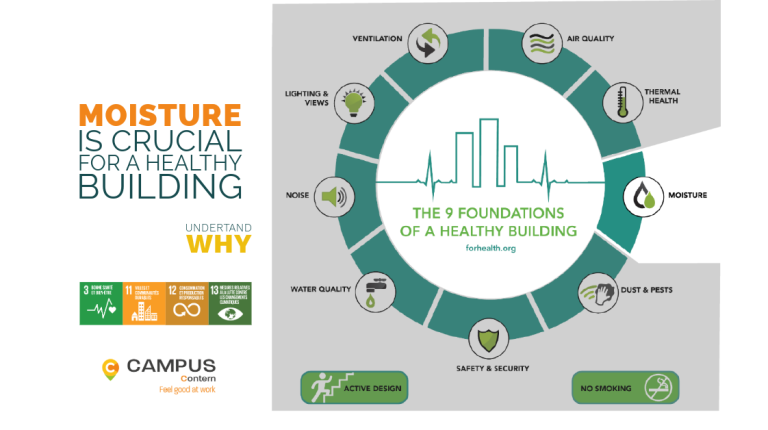Moisture control in buildings is crucial for maintaining healthy indoor environments, as excessive moisture can lead to significant health risks and reduced productivity.
Studies from Europe, Canada, and the U.S. reveal that up to 36% of homes and 85% of office buildings have experienced water damage, contributing to mold growth and related health issues.
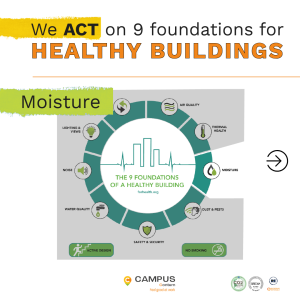
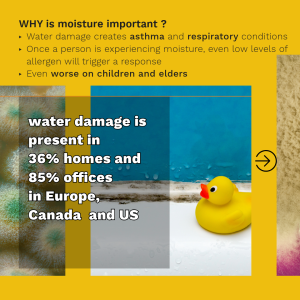
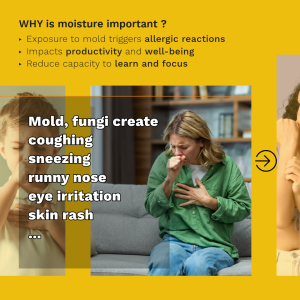
Why does moisture matter?
Mold thrives in damp conditions, often unnoticed in materials like wallboard, carpeting, or HVAC systems.
Common sources of moisture include leaks, condensation, poor insulation, and inadequate ventilation of kitchen and shower rooms.
Moisture creates ideal conditions for mold spores to grow on surfaces such as carpets, ceiling tiles, and walls. Mold exposure releases irritating spores and volatile organic compounds (VOCs) that degrade air quality.
How does it affect people’s health :
Excessive moisture can trigger respiratory issues, such as asthma and allergic reactions, particularly among vulnerable populations like children, the elderly, and those with compromised immune systems.
The U.S. Environmental Protection Agency (EPA) estimates that residential dampness and mold exposure contribute to 21% of asthma cases annually, aggravating symptoms (sneezing, runny nose, eye irritation, coughing, skin rash…) for millions of individuals.
How does moisture affect productivity :
The negative effects of moisture also impact productivity and learning environments.
In office buildings, employees exposed to mold-related issues report increased asthma, allergies, and respiratory infections, leading to absenteeism and reduced workplace performance. A Swedish study found that moisture-related problems in offices led to a spike in complaints and health issues, particularly in older, poorly ventilated buildings.
Schools are also heavily affected, with both teachers and students experiencing mold-related health issues. Teachers have a higher prevalence of asthma, comparable to blue-collar workers, leading to reduced quality of life, lower productivity, and more sick days.
Students, who spend thousands of hours in school buildings, also face higher absenteeism and reduced learning performance due to respiratory symptoms caused by mold. These symptoms often improve during weekends and holidays, underscoring the impact of moisture-damaged learning environments on student well-being and academic success.
Effective moisture control is thus essential for healthier, more productive indoor environments in both workplaces and schools.
@CAMPUS CONTERN it means :
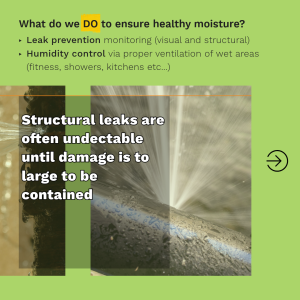

- We watch for leaks both visually and by monitoring water consumption to spot any dysfunction
- Solutions and tests are quickly set in place and are monitored for a long period after the event to make sure that the problem is properly solved
- Damage areas are disinfected and thoroughly repaired to prevent potential fungi growth
- Ventilation is adapted to guarantee a proper moisture level
- Fitness, changing room, sanitaires and kitchens are equipped with extraction and ventilations suited for wet rooms.
- Our indoor air purification system help prevent fungi growth as the positive bacteria are effective in eliminating microscopic spores.
Our Goal :
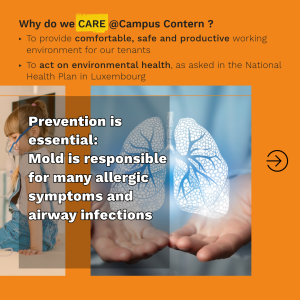
- To make sure that our tenants have a safe and healthy work environment. They spend a lot of time in our buildings, it is our responsibility to do our best to reduce the causes of fatigue, absenteeism and to foster concentration and performance
- To protect our tenants from chronicle diseases and play our part in the National Health Plan
Source : “The 9 foundations of a healthy building” Harvard School of Public Health – forhealth.org
